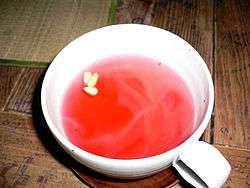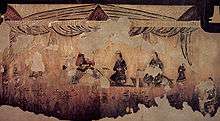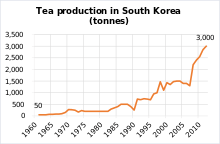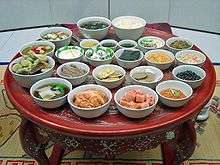Korean tea

Korean tea (Korean: 차 Korean pronunciation: [tɕʰaː]) is a Korean traditional tea which is a variety of herbal and plant infusions, including the leaves of the tea bush (Camellia sinensis). Like brews made from tea leaves, Korean tea is prepared by infusing fruits, leaves, roots, or grains in hot water. The resulting drink is served hot or cold.
History




The first historical record documenting the offering of tea to an ancestral god describes a rite in the year 661 in which a tea offering was made to the spirit of King Suro, the founder of the Geumgwan Gaya Kingdom (42-562). Records from the Goryeo Dynasty (918-1392) show that tea offerings were made in Buddhist temples to the spirits of revered monks.
During the Joseon Dynasty (1392-1910), the royal Yi family and the aristocracy used tea for simple rites, the "Day Tea Rite" was a common daytime ceremony, whereas the "Special Tea Rite" was reserved for specific occasions. These terms are not found in other countries.
Toward the end of the Joseon Dynasty, commoners joined the trend and used tea for ancestral rites, following the Chinese example based on Zhu Xi's text Formalities of Family.
Drinking of green tea by common people in Korea was not popular until recently. Commercial production of green tea in South Korea began in 1970s.[1] Even in 2012, production of tea in South Korea is 20% of Taiwan and 3.5% of Japan and tea consumption per capita is less than one tenth of other East Asian countries.[2][3]
Culture
Types
 |
| This article is part of a series on |
| Korean cuisine 한국 요리 조선 료리 |
|---|
|
Staples |
|
|
Made from roots
Insam cha
Insam cha (인삼차, 人蔘茶) is a tea made from ginseng, which can be a fresh ginseng (수삼, 水蔘), a dried ginseng (건삼, 乾蔘) or a red steamed ginseng (홍삼, 紅蔘). The sliced or whole ginseng is boiled for a few hours, and then refined sugar (or unrefined sugar such as honey) may be added. A common ratio is 500 mℓ of water to 50 g of ginseng. Sometimes, jujube can be added when boiled.
- Efficacy in Traditional Beliefs: Some believe that Insam cha is good for increasing energy, especially for someone who catches colds frequently in winter. It also has a remedial effect on stomachaches due to low body temperature. However, neither belief has been shown in independent scientific evaluations.
Danggwi cha
Danggwi cha (당귀차, 當歸茶) is a tea made from boiling the dried root of Korean angelica (Angelica gigas). The dried root of Korean angelica is gently boiled in water for a few hours. Sometimes, ginger root can be added for preference when boiled.
- Efficacy in Traditional Beliefs: Korean angelica is often called ginseng for woman. Some believe that it is good for (white) leucorrhoea and postpartum care. If consumed for a long time, it can remedy cold fingers or toes. However, neither belief has been shown in independent scientific evaluations.
Saenggang cha
Saenggang cha (생강차, 生薑茶) is a tea made from ginger root. The ginger root is washed and sliced without peeling. The sliced ginger root is stored with honey for a few weeks. To make tea the mixed honey and ginger root is added to hot water.
- Efficacy in Traditional Beliefs: Some believe that Saenggang Cha is useful to prevent colds and to aid digestion. It also has a remedial effect on diarrhea and stomachache due to low body temperature. It helps someone who has a low body temperature due to bad circulation. However, neither belief has been shown in independent scientific evaluations.
Others
- Chik cha (칡차) - made from kudzu root
- Dunggulle cha (둥굴레차) - made from dried root of Solomon's seal.
- Ma cha (마차, 麻茶 or 산약차) - made from the root of gastrodia
Made from fruits

- Sujeonggwa - punch made from dried persimmons, ginger, and cinnamon
- Yujacha (유자차, 柚子茶) - Yuzu teaphoto
- Gugijacha (구기자차, 枸杞子茶) - made from dried wolfberries
- Daechucha - made from jujubesphoto
- Omijacha (오미자차, 五味子茶): Tea made from dried fruits of Schisandra chinensis. Omija cha is named because the tea comprises five distinct flavors: sweet, sour, salty, bitter, and pungent.
- Maesilcha (매실차, 梅實茶): green fruits of a maesil and sugar is added to water, and then fermented for a month or so. Be careful not to produce alcohol.
- Mogwacha - the fruit of a Pseudocydonia, or Chinese quince, is sliced, and then it is stored and fermented in large bowl with sugar and water for a month or so. Take care that the mixture does not become alcoholic.
- Sansuyu cha (산수유차, 山茱萸茶) - made from a fruit of Cornus officinalis, which is a variety of dogwood.
- Taengja cha (탱자차, 橙子茶) - the fruit of the trifoliate orange and sugar are added with water and allowed to ferment for a month or so.
Made from grains and seeds
- Bori cha (보리차, 菩提茶): roasted barley tea
- Oksusu cha (옥수수차): roasted corn tea
- Hyeonmi cha (현미차, 玄米茶): roasted rice tea
- Yulmucha (율무차): Job's tears tea
- Gyeolmyeongja cha (결명자차, 決明子茶): Tea made from roasted Senna obtusifolia seeds
Made from leaves
- Nok cha (녹차): this is most common form of Korean green tea using dried leaves from the Camellia Sinensis plant.
- Bbongip cha (뽕잎차): dried mulberry leaves
- Gamip cha (감잎차): dried persimmon leaves
- Solip cha (솔잎차): pine needles
- Gukhwa cha (국화차,菊花茶) - wild chrysanthemum flowers are preserved in honey for a month or so, and then mixed with hot water
- Ilsulcha (이슬차): Hydrangea serrata (산수국, 山水菊) leaves
- Pakha cha (박하차): peppermint leaves
Others
- Yeongji-beoseot-cha (영지버섯차, 靈芝茶) : tea made from dried Ganoderma lucidum fungus
- Songhwa milsu (송화밀수, 松花蜜水): Pine pollen and honey are added to water
- Gyulgang cha (귤강차, 橘薑茶): the skin of mandarin oranges is dried and cleaned, and then it is boiled in water. Serve the boiled water with honey.
- Ssanghwa cha (쌍화차, 雙和茶): Tea made from a few materials of traditional Korean medicine such as steamed and dried root of Rehmannia glutinosa (숙지황, 熟地黃), dried root of Angelica gigas (당귀, 當歸), the dried root of Ligusticum officinale (천궁, 川芎), the dried root of Paeonia obovata (작약,芍藥), cinnamon bark, the dried root of Glycyrrhiza glabra (감초, 甘草) and the root of Astragalus membranaceus (황기, 黃芪).
- Duchung cha (두충차, 杜仲茶): Tea made from the skin of Eucommia ulmoides tree.
- Donggyuja cha (동규자차, 冬葵子茶): Tea made from seed of Malva verticillata
- Salgunamu cha (살구나무차): Made from apricot seed kernels
- Gamro cha (감로차, 甘露茶): Tea made from juice of maple leaves, Celtis sinensis, Catalpa ovata, and Quercus dentata
See also
| Wikimedia Commons has media related to Tea of Korea. |
References
- ↑ Lee, Geumdong (2014). "The Leaders' Contribution of the Formative Period of Korea's 3 Main Tea Producing Areas" (PDF). Bulletin Faculty Agriculture, Saga University. pp. 1–20.
- ↑ "FAOSTAT > Food Balance > Food Supply > Crops Primary Equivalent". FAO.
- ↑ "Crops, Production, FAOSTAT". FAO.
- 단방약차선 at 겨레의 자연건강 (Korean)